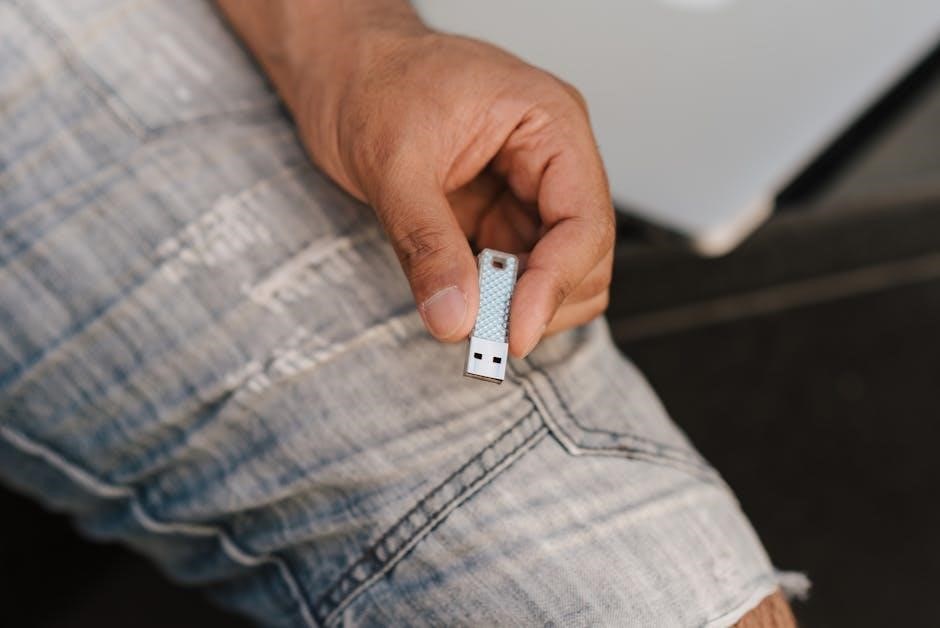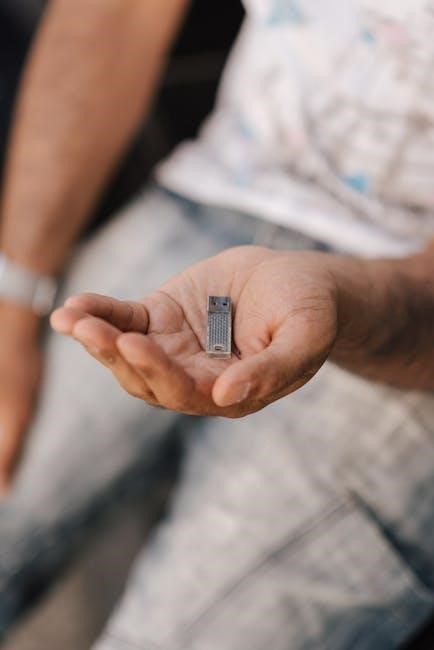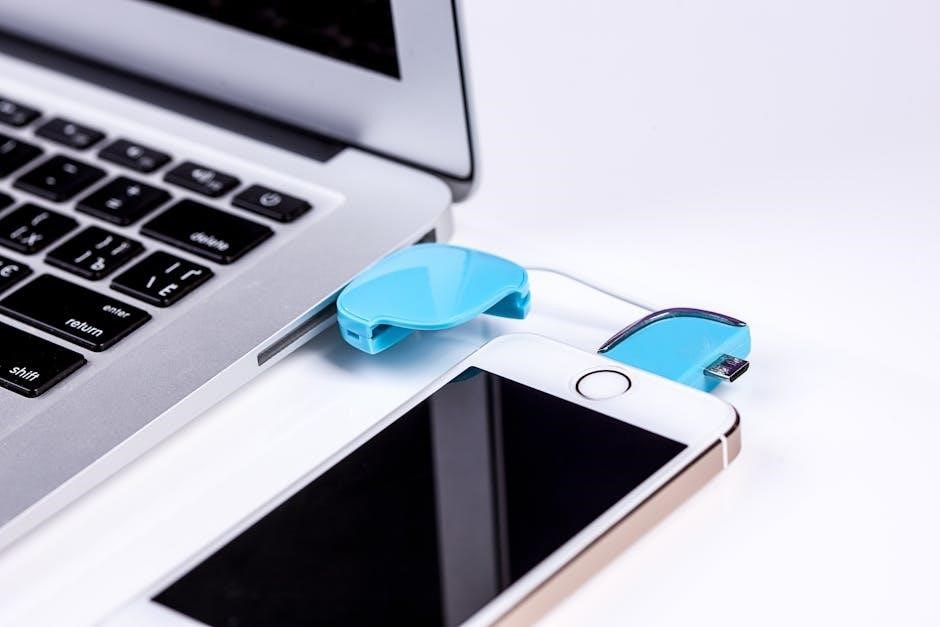usb hub data transfer guide
USB hubs are an essential tool for expanding connectivity‚ enabling efficient data transfer between devices․ They enhance convenience by connecting multiple peripherals‚ ensuring seamless file sharing and device charging․
What is a USB Hub?
A USB hub is a device that expands a single USB port into multiple ports‚ allowing users to connect several peripherals to their computer simultaneously․ It acts as a bridge‚ enabling communication and data transfer between the host device and connected peripherals․ USB hubs are designed to simplify connectivity‚ offering a convenient solution for users who need to attach multiple devices like flash drives‚ external hard drives‚ printers‚ or keyboards․ They are user-friendly‚ requiring minimal setup‚ and are widely compatible with various operating systems․ Whether basic or advanced‚ USB hubs enhance productivity by providing additional ports and supporting seamless interaction between devices․
Why Use a USB Hub for Data Transfer?
Using a USB hub for data transfer offers enhanced convenience and efficiency‚ especially when handling multiple devices․ It allows users to connect several peripherals simultaneously‚ streamlining file transfers and reducing the need to constantly swap devices․ This is particularly beneficial for professional workflows‚ such as media editing or data management‚ where time is critical․ Additionally‚ USB hubs provide a centralized connection point‚ minimizing clutter and improving workspace organization․ They also support backward compatibility‚ ensuring older devices can still be used with newer systems․ By expanding connectivity options‚ USB hubs are an indispensable tool for anyone seeking to optimize their data transfer processes and maintain productivity․

Understanding USB Hub Data Transfer
USB hub data transfer involves managing speeds based on port types‚ cable quality‚ and connected devices․ Efficient drivers and system configuration maximize data flow efficiency and reliability․
Factors Affecting Data Transfer Speed
Several factors influence USB hub data transfer speeds‚ including the USB version (2․0‚ 3․0‚ 3․1/3․2)‚ cable quality‚ and device capabilities․ The host computer’s processing power and system configuration also play a role․ Additionally‚ the number of connected devices and their individual bandwidth requirements can impact performance․ High-quality cables and efficient drivers ensure optimal data flow‚ while older or lower-grade components may introduce bottlenecks․ Matching the speed of devices to the hub’s specifications helps maximize efficiency․ Understanding these factors is crucial for achieving reliable and fast data transfer rates across all connected peripherals․
Importance of Cable Quality in Data Transfer
Cable quality significantly impacts USB hub data transfer efficiency․ High-grade cables ensure faster speeds and reliable connections‚ while low-quality ones cause bottlenecks and signal loss․ Using cables rated for the USB version in use maximizes performance․ For instance‚ USB 3․0 cables support up to 5Gbps‚ but using a USB 2․0 cable with a USB 3․0 hub limits speed to 480Mbps․ Durable materials and proper shielding in cables minimize interference and ensure consistent data flow․ Investing in premium cables guarantees optimal performance‚ preventing slowdowns and disconnections that hinder productivity․ Always match cable specifications to the hub and device capabilities for seamless data transfer experiences․
USB Hub Types and Specifications
USB hubs vary by version‚ with USB 2․0‚ 3․0‚ and 3․1/3․2 offering increasing speeds of 480Mbps‚ 5Gbps‚ and up to 20Gbps‚ respectively‚ ensuring compatibility and enhanced data transfer rates․
USB 2․0 Hubs
USB 2․0 hubs are entry-level devices offering reliable connectivity for basic applications․ They support data transfer speeds up to 480 Mbps‚ suitable for low-bandwidth devices like keyboards‚ mice‚ and printers․ These hubs are backward compatible with older USB 1․1 devices‚ making them versatile for legacy systems․ While slower than newer versions‚ USB 2․0 hubs remain cost-effective and ideal for users with limited data transfer needs․ They often come in compact designs‚ making them portable and easy to use․ However‚ they may not be the best choice for high-speed data transfer tasks‚ such as handling large files or multimedia content․
USB 3․0 Hubs
USB 3․0 hubs deliver high-speed data transfer rates of up to 5 Gbps‚ making them ideal for applications requiring faster connectivity․ They are backward compatible with USB 2․0 devices‚ ensuring versatility across different hardware․ These hubs are perfect for connecting external storage devices‚ cameras‚ and video equipment‚ where speed is crucial․ Many USB 3․0 hubs come with built-in charging capabilities‚ allowing users to power devices while transferring data․ They are widely adopted for professional and consumer use‚ offering a balance between performance and affordability․ Popular models‚ like the Anker 7-Port USB 3․0 Data Hub‚ provide reliable connections and efficient data transfer‚ catering to media professionals and gamers alike․
USB 3․1/3․2 Hubs
USB 3․1 and 3․2 hubs represent the pinnacle of high-speed data transfer‚ offering rates up to 10-20 Gbps․ These hubs are designed for professional and high-bandwidth applications‚ supporting demanding tasks like 4K video editing and data-intensive operations․ They are backward compatible with earlier USB versions‚ ensuring seamless integration with existing devices․ USB 3․2 hubs often feature advanced power delivery options‚ supporting high-power peripherals․ Their robust build and high-speed capabilities make them ideal for industrial and professional environments where data transfer efficiency is critical․ These hubs are a significant upgrade for users needing faster and more reliable connections‚ catering to the growing demands of modern technology․

Best Practices for Optimal Data Transfer
For optimal data transfer‚ ensure speed matching between devices and hubs‚ use high-quality cables‚ and minimize simultaneous transfers․ Avoid long cables and outdated drivers for best results․
Speed Matching for Maximum Efficiency
Speed matching is crucial for maximizing data transfer efficiency․ Ensure your USB hub and connected devices operate at the same USB version to avoid bottlenecks․ For example‚ pairing a USB 3․0 device with a USB 3․0 hub and cable ensures optimal speeds up to 5 Gbps․ Mismatched versions can reduce performance‚ as the system will default to the slowest component․ Always verify the specifications of both the hub and devices to maintain compatibility․ This approach minimizes latency and ensures reliable data flow․ By aligning speeds‚ you can achieve faster transfers and enhance overall productivity․ Proper speed matching is essential for seamless connectivity and efficient data management․
Using High-Quality Cables and Drivers
High-quality cables and drivers are vital for optimal data transfer performance․ Poor-quality cables can bottleneck speeds‚ even with fast USB hubs․ Always use cables rated for the same or higher speed as your hub․ Additionally‚ ensure drivers are up-to-date‚ as outdated ones can cause latency or disconnections․ Drivers act as intermediaries between devices and systems‚ ensuring smooth communication․ For USB 3․0 and above‚ certified cables with proper shielding are recommended to minimize interference․ Regularly update hub drivers from trusted sources to maintain compatibility and efficiency․ Investing in premium cables and keeping drivers current ensures reliable and fast data transfer‚ maximizing your USB hub’s potential and overall system performance․

Popular USB Hubs for Data Transfer
Top-tier USB hubs like the Anker 7-Port‚ Ugreen USB-C‚ and Raspberry Pi Hub offer reliable connectivity and fast data transfer‚ catering to diverse user needs efficiently․
Anker 7-Port USB 3․0 Data Hub
The Anker 7-Port USB 3․0 Data Hub is a versatile and efficient solution for users needing multiple high-speed connections․ With seven USB 3․0 SuperSpeed ports‚ it delivers up to 5Gbps transfer rates‚ making it ideal for tasks like transferring large files‚ connecting external hard drives‚ and supporting multimedia devices․ Its compact design and built-in power adapter ensure reliable performance‚ while surge protection and a sturdy construction provide long-term durability․ This hub is perfect for professionals and gamers who require consistent and fast data transfer speeds across multiple devices․ Its compatibility with USB 2․0 devices adds flexibility‚ ensuring it meets a wide range of connectivity needs․
Ugreen USB-C 4-Port Hub
The Ugreen USB-C 4-Port Hub offers a sleek and cost-effective solution for expanding connectivity․ It features four USB 3․0 ports‚ each capable of delivering data transfer speeds up to 5Gbps‚ making it suitable for high-speed file transfers and connecting peripherals․ Designed with a slim profile‚ this hub is both portable and convenient‚ perfect for users on the go․ It supports multiple devices simultaneously‚ ensuring efficient multitasking․ The hub’s USB-C compatibility enhances its versatility‚ allowing it to work seamlessly with modern laptops and devices․ Its upgraded design ensures reliable performance and durability‚ making it a practical choice for both personal and professional use‚ while maintaining backward compatibility with USB 2․0 devices for enhanced flexibility;
Raspberry Pi USB 3․0 Hub
The Raspberry Pi USB 3․0 Hub is a specialized accessory designed to enhance the connectivity of Raspberry Pi devices․ It offers high-speed data transfer capabilities‚ with USB 3․0 ports supporting speeds up to 5Gbps‚ ideal for external storage and peripherals․ The hub includes a power transfer feature‚ delivering up to 900mA (4․5W)‚ and supports an optional external USB-C power input for high-power devices‚ ensuring stable performance․ Its compact design integrates seamlessly with Raspberry Pi systems‚ making it a versatile tool for projects requiring reliable data transfer and efficient power management․ This hub is particularly favored in DIY and professional setups where expanded connectivity and robust performance are essential․

Troubleshooting Common Data Transfer Issues
Identify bottlenecks like slow speeds or dropped connections․ Check cable quality‚ ensure proper driver updates‚ and verify device compatibility to resolve issues efficiently․
Identifying Bottlenecks in Data Transfer
Identifying bottlenecks in data transfer involves examining hardware and software components․ Slow speeds may result from outdated drivers‚ low-quality cables‚ or mismatched USB versions (e․g․‚ using USB 3․0 devices with USB 2․0 hubs)․ Additionally‚ the host computer’s processing power and storage speed can limit transfer rates․ Overloaded hubs with too many devices connected simultaneously can also cause bottlenecks․ Ensuring all components are optimized for the desired speed‚ such as using USB 3․2 Gen 2 cables with compatible hubs‚ helps maximize efficiency․ Regularly updating drivers and avoiding overloaded connections are key to maintaining optimal data flow․
Resolving Connectivity and Speed Problems
Resolving connectivity and speed issues starts with diagnosing the root cause․ Ensure all cables and ports are undamaged‚ as physical damage can disrupt data flow․ Updating USB hub drivers to the latest versions often resolves compatibility issues; Restarting the system or re-plugging devices can also reset connections․ For slow speeds‚ verify that all components‚ including cables and hubs‚ match the desired transfer rate (e․g․‚ USB 3․2 Gen 2)․ Overloaded hubs can be relieved by connecting high-bandwidth devices directly to the host computer․ Using powered hubs prevents power shortages‚ especially with multiple devices․ Regular maintenance‚ such as checking for driver updates‚ ensures optimal performance and minimizes data transfer disruptions․
